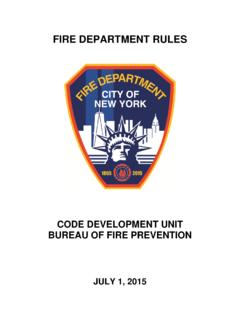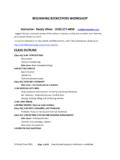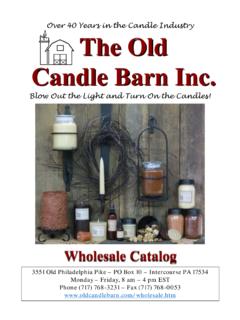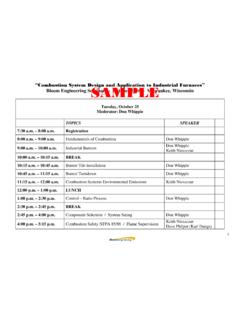Transcription of Refractory Degradation in Glass tank Melters. A …
1 CER MICA 43 (283-284) 1997178 INTRODUTIONThe major objective in Glass tank melters is to optimize theentire process by reducing the maximum temperature of melting,improving Refractory performance and/or improving melter fuelefficiency. The required characteristics of refractories used in meltersare: thermal shock resistance, corrosion resistance, controlledexpansion behavior, low thermal conductivity, and adequate corrosion of the refractories in the melter may be due tobatch carryover (lime, soda, fluorides, lead oxide, borax, silica, otherglass constituents), volatile fluxes ( , volatile alkali oxidespenetrating pores, where solid, liquid, and gas coexist), and meltattack, mainly at the metal line.
2 Erosion often follows the initialcorrosion, washing away Refractory grains after the original bondhas dissolved. Corrosion test designs are usually based on operationand reaction temperatures, reaction rates, and the formation ofcoatings on the Refractory for Glass furnaces normally are limited tocompositions based on A12O3, ZrO2, and SiO2, with or without (AZS) refractories in contact with moltenglass form a viscous silicate layer adjacent to the Refractory thusrestricting contact, and therefore, increasing corrosion AZS blocks are used in superstructures, they are exposed tohigh temperature combustion products.
3 At temperatures above 1475 0C,the bond strength between the embedded ZrO2 crystals and thealumina is reduced, attributed to the variation in the thermalexpansion characteristics of A12O3 and and crown refractories are subjected tocorrosive reactions with the vapor species of the batch componentsand batch carryover. In the melting of soda-lime glasses, the vaporspecies are primarily soda and sodium sulfates; for borosilicateRefractory Degradation in Glass tank melters . A Survey of Testing MethodsM. Velez, J. Smith, R. E. Moore. University of Missouri-Rolla,Department of Ceramic Engineering, Rolla, Missouri 65409-0330, USAglasses, Na-tetraborate and B2O3 predominate.
4 Direct attack occursby condensation of the hot face of the Refractory . The chemicalchanges in this reaction zone result in mechanical stresses andflaking, peeling or spalling of the hot face. Vapor penetration intojoints with subsequent condensation and corrosion lowers themechanical integrity of the superstructure or work intends to summarize the tests to date, discussingtheir particular advantages, and emphasizing the corrosion ofrefractories in the melter tank. Most future melters are predicted tobe under oxy-fuel combustion [1,2], with limited use of SEARCHC orrosion resistance of refractories to molten slagsSeveral methods have been used to evaluate the dissolutionrate of refractories, including (1) before and after profilemeasurements [ , 3-7]; (2) measurement of the change in weight[ , 8-10]; (3) electrochemical approaches [ , 11,12]; and (4)continuous gravimetric monitoring [ , 13-15].
5 The currentstandard tests for refractories in contact with molten slags include:isothermal corrosion resistance of refractories to molten Glass [16];corrosion resistance of refractories to molten Glass while atemperature gradient is maintained through the Refractory [17]; cupslag test; drip slag test [18]; gradient slag test; rotary slag test; andthe dip and spin test [19]. These laboratory corrosion tests compa-re corrosion characteristics, effectively measuring the chemicalcompatibility between Glass and [3] considered the different factors influencing thecorrosion of refractories by commercial glasses. Given assumptionssuch as pure diffusion, entirely electrochemical processes and aAbstractThe Degradation of refractories used in the construction of Glass meltingfurnaces, whether caused by the action of molten Glass , vaporized melt constituents,products of fuel combustion, or by batch dusts and vapors, can normally only beassessed after a campaign when the furnace is partially or completely tests to predict Degradation usually employs small specimens exposedto accelerated working conditions which might not be simulative.
6 The currenttesting procedures are discussed in terms of advantages/disadvantages. Threedifferent tests seem to be needed to simulate the critical processes occurring inglass tank melters : flux-line corrosion, throat corrosion and crown corrosion. Apilot-size laboratory testing facility is being built for simulating corrosion attackunder different MICA 43 (283-284) 1997179uniform microstructure of the Refractory , there are three corrosionmechanisms, forced convection, density induced free convection,and surface tension driven convection. He concluded that the surfacetension has perhaps the strongest influence on [20] studied the corrosion rates of various refractoriesin a container Glass melt (Na-Ca-silicate) and determinedquantitatively the action of forced convection flow by means of arotating cylinder at 1400 and 1500 oC.
7 The corrosion rates weredetermined by measuring the decrease in length of cylindricalsamples as a function of time at various rotation rates. The differentinitial stages of corrosion with Refractory materials and a Na-Ca-silicate and E- Glass melts was also investigated [21-22]. Thecorrosion of refractories by Glass melts under the influence ofdensity-, interfacial-, and forced-convection currents showed a li-near dependence on time for the static corrosion process with respectto theoretical AZS materials contain zirconia crystals 30-40wt. %, interlocked with corundum, and minor interstitial Glass .
8 Theyperform well in contact with many glasses melted at 1500 oC orlower, but have been found to react readily with new developmentalglasses, particularly rare earth alumino-silicates having much highermelting temperatures, resulting in erosion of crystalline particleswhich appears as stones in the Glass . Some molten glasses withhigher melting temperatures cause high rates of corrosive wear ofthe 30-40 wt. % ZrO2 refractories [23]. The alumino-silicate formsan undesirable surface layer on the Refractory when cooled uponshutdown for repairs. When the tank is reheated, the surface layerin contact with molten Glass undergoes [24] tested SiO2, Al2O 3, and ZrO2 in contact withsilicate glasses containing large amounts of PbO (66 wt.)
9 %, Glass I; wt. %, Glass II). Static conditions were used with the specimenssemi-immersed, during 24-72 h at 1300 oC for Glass I, while for themore corrosive Glass II, 6-12 h at 1000 oC. Specimens were cut andexamined by optical microscopy. Corrosion resistance increased inthe sequence SiO2<A12O3<MgO<ZrO2. The corrosive contactinvolves lead diffusing into the tetragonal ZrO2, and subsequentZrO2 fused-cast Refractory materialsmanufactured under reducing conditions during melting, have atendency to form defects when they are in contact with Glass , as aresult of reactions with oxygen-containing impurities [25].
10 Aluminafused cast refractories formed bubbles after contact with the were placed in a furnace on a Refractory substrate, heatedto the specified temperature (1250 oC ), and held for 15 min. Twoglass rods (10-15 mm long, 9 mm diameter) were placed on eachspecimen and again held at the temperature for 15 min. During thesecond dwell, drops of Glass saturated with bubbles covered thesurface of the [26] evaluated corrosion data of bonded alumina-chrome refractories (10 and 16 wt. % Cr2O3) and observed thatthey yield high corrosion resistance to soda-lime Glass . He concludedthat these refractories could be used as bottom pavers, sidewalls,and back-up shapes for high thermal efficiency construction.
















